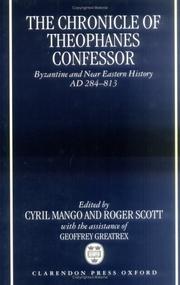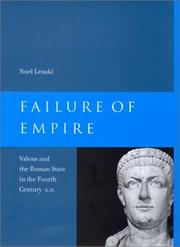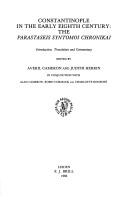| Listing 1 - 7 of 7 |
Sort by
|

ISBN: 0198225687 9780198225683 Year: 1997 Publisher: Oxford: Clarendon,
Abstract | Keywords | Export | Availability | Bookmark
 Loading...
Loading...Choose an application
- Reference Manager
- EndNote
- RefWorks (Direct export to RefWorks)
Byzantine Empire --- History --- Empire byzantin --- Histoire --- Isaurian dynasty, 717-811 --- Byzantine Empire - History - Isaurian dynasty, 717-811

ISBN: 3774918570 9783774918573 Year: 1981 Volume: 2 Publisher: Bonn: Habelt,
Abstract | Keywords | Export | Availability | Bookmark
 Loading...
Loading...Choose an application
- Reference Manager
- EndNote
- RefWorks (Direct export to RefWorks)
Iconoclasm --- Artavasdos, --- Byzantine Empire --- History --- Idols and images --- Worship --- Artavasdos --- -Byzantine Empire --- -History --- -Iconoclasm --- Artabasdos, --- Artavasdo, --- Artavasdos, - active 8th century --- Byzantine Empire - History - Leo III the Isaurian, 717-741 --- Byzantine Empire - History - Constantine V Copronymus, 741-775

ISBN: 3050007001 9783050007007 Year: 1991 Volume: 57 Publisher: Berlin: Akademie,
Abstract | Keywords | Export | Availability | Bookmark
 Loading...
Loading...Choose an application
- Reference Manager
- EndNote
- RefWorks (Direct export to RefWorks)
Theophanes, --- Byzantine Empire --- Empire byzantin --- History --- Sources --- Histoire --- Theophanes the Confessor --- -Sources --- -History --- -Theophanes the Confessor --- -Theophanes, --- -Byzantium (Empire) --- Vizantii︠a︡ --- Bajo Imperio --- Bizancjum --- Byzantinē Autokratoria --- Vyzantinon Kratos --- Vyzantinē Autokratoria --- Impero bizantino --- Bizantia --- Sources. --- Byzantium (Empire) --- Theophanes, - the Confessor, - -approximately 818 - Chronographia - Sources --- Byzantine Empire - History - Isaurian dynasty, 717-811 - Sources --- Theophanes, - the Confessor, - -approximately 818 - Chronographia
Book
ISBN: 9781846316982 9781846316975 1846316979 1846316987 1789628733 Year: 2011 Volume: 57 Publisher: Liverpool: Liverpool university press,
Abstract | Keywords | Export | Availability | Bookmark
 Loading...
Loading...Choose an application
- Reference Manager
- EndNote
- RefWorks (Direct export to RefWorks)
Theophilus of Edessa was an astrologer in the court of the Muslim caliphs from the 750s to the 780s, a time when their capital, Baghdad, was a thriving cosmopolitan centre of culture and trade and one of the most populous and prosperous cities of the world. He was fluent in Greek, Syriac and Arabic, and he used this ability to bring together a number of historical sources in each of these languages and blend them into a single chronicle that charted events in the Near East from 590 to the 750s. His work is no longer extant, but it was cited extensively by a number of later historians and Robert Hoyland has collected and translated all these citations so as to give an impression of the scope and content of the original text. This is important, because this chronicle underlies much of our historical knowledge about the seventh and eighth century Near East, which was a crucial period in the region, witnessing as it did the devastating war between the two superpowers of Byzantium and Iran, the Arab conquests and the rise to power of the first Muslim Arab dynasty, the Umayyads (660-750), and their subsequent overthrow by a new dynasty, the Abbasids, who moved the capital of the Muslim Empire from Damascus to Baghdad. Hoyland also indicates the links between Theophilus’ chronicle and other historical works, by Muslims as well as Christians, in order to illustrate the considerable degree of sharing of historical ideas and information that occurred among the various communities of the Near East. The material translated consists of the sections of four chroniclers that deal with the period 590-750s: one in Greek (Theophanes the Confessor, d. 818), one in Arabic (Agapius of Manbij, fl. 940s) and two in Syriac (Michael the Syrian, d. 1199, and an anonymous author, fl. 1230s, who were both relying on the chronicle of Dionysius of Telmahre, d. 845). The latter three either had not been translated into English before (thus Agapius and Michael the Syrian) or had only partially been translated (the anonymous chronicler of the 1230s).
World history --- Histoire universelle --- Early works to 1800. --- Ouvrages avant 1800 --- Theophilus, --- Islamic Empire --- Byzantine Empire --- Empire islamique --- Empire byzantin --- History --- Histoire --- Middle East --- World history - Early works to 1800 --- Theophilus, - of Edessa, - 695-785. - Chronicle --- Islamic Empire - History - 661-750 --- Byzantine Empire - History - Isaurian dynasty, 717-811
Book
ISBN: 9782874570667 2874570664 Year: 2013 Volume: 5 Publisher: Bruxelles: Safran,
Abstract | Keywords | Export | Availability | Bookmark
 Loading...
Loading...Choose an application
- Reference Manager
- EndNote
- RefWorks (Direct export to RefWorks)
Personne ne peut prétendre connaître Byzance ou son histoire et ignorer la Chronique de Théophane. Cet ouvrage constitue pour l’historiographie byzantine le point de passage d’un temps historique « avant Théophane » à un temps « après Théophane ». Sa popularité est en outre manifeste du fait qu’elle servait de livre scolaire, même pour les princes, pour l’apprentissage de l’Histoire. Le fait qu’Anastase le Bibliothécaire l’a choisi pour le traduire en latin, est la preuve irréfutable de l’autorité scientifique de la Chronique dans le monde occidental. Or, il faut être un spécialiste pour apprécier le débat acharné autour du rôle de Théophane à la composition de cet ouvrage transmis sous son nom. Cette question, qui tourmente la recherche historique depuis de Xe siècle, ne peut toutefois pas être dissociée de l’étude de la personnalité, toujours énigmatique, de Théophane. Qui était alors Théophane ? Qui était cet homme, né dans un milieu iconoclaste, qui a terminé sa vie comme confesseur de la cause des icônes ? Cet homme, né dans l’opulence, qui après un mariage de raison, prit l’habit monastique et passa sa vie comme un humble moine ? Comment, de cet homme ordinaire, le parti iconophile a créé un héros de la cause des icônes ? Et pourquoi, au Xe siècle Constantin, VII le Porphyrogénète et la propagande du Palais ont voulu propager la légende de Théophane ancêtre impérial et saint officiel de la cour ?
Beeldenstorm en beeldenstrijd --- Beeldenstrijd -- Geschiedenis --- Beeldenstrijd en beeldenstorm --- Iconoclasm --- Iconoclasm -- History --- Iconoclasme --- Iconoclasme -- Histoire --- Iconoclasme et iconoclastie --- Iconoclastie et iconoclasme --- Images [Querelle des ] --- Querelle des Images --- Theophanes, --- History and criticism --- Byzantine Empire --- History --- Theophanes the Confessor --- Theophanes continuatus --- Sources --- Theophanes conf. Sigrianae chronographus --- Theophanes, - the Confessor, - -approximately 818 --- Theophanes, - the Confessor, - -approximately 818 - Chronographia - History and criticism --- Byzantine Empire - History - Isaurian dynasty, 717-811 - Sources --- Theophanes, - the Confessor, - -approximately 818 - Chronographia

ISBN: 0520928539 1597346101 0520233328 0520283899 9780520928534 9780520233324 9781597346108 Year: 2002 Publisher: Berkeley : University of California Press,
Abstract | Keywords | Export | Availability | Bookmark
 Loading...
Loading...Choose an application
- Reference Manager
- EndNote
- RefWorks (Direct export to RefWorks)
Failure of Empire is the first comprehensive biography of the Roman emperor Valens and his troubled reign (a.d. 364-78). Valens will always be remembered for his spectacular defeat and death at the hands of the Goths in the Battle of Adrianople. This singular misfortune won him a front-row seat among history's great losers. By the time he was killed, his empire had been coming unglued for several years: the Goths had overrun the Balkans; Persians, Isaurians, and Saracens were threatening the east; the economy was in disarray; and pagans and Christians alike had been exiled, tortured, and executed in his religious persecutions. Valens had not, however, entirely failed in his job as emperor. He was an admirable administrator, a committed defender of the frontiers, and a ruler who showed remarkable sympathy for the needs of his subjects. In lively style and rich detail, Lenski incorporates a broad range of new material, from archaeology to Gothic and Armenian sources, in a study that illuminates the social, cultural, religious, economic, administrative, and military complexities of Valens's realm. Failure of Empire offers a nuanced reconsideration of Valens the man and shows both how he applied his strengths to meet the expectations of his world and how he ultimately failed in his efforts to match limited capacities to limitless demands.
Rome - History - Valentinian I, 364-375. --- Valens,-- Emperor of the East,-- approximately 328-378. --- Regions & Countries - Europe --- Greece --- History & Archaeology --- Valens, --- Valentinian --- Flavius Valentinianus --- Valentinianus --- Valentiniano --- Flavio Valente, --- Valente, --- Byzantine Empire --- Rome --- History --- Histoire --- HISTORY / Ancient / General. --- antioch. --- archaeology. --- arian crisis. --- armenia. --- balkans. --- barbarian history. --- battle of adrianople. --- battle. --- biography. --- bureaucracy. --- byzantine. --- christianity. --- constantin. --- discipline. --- emperor. --- empire. --- fall of an empire. --- frontier. --- gothic war. --- goths. --- government. --- history. --- iberia. --- imperialism. --- invasion. --- isaurian. --- late roman. --- military. --- pagans. --- pannonian emperors. --- persia. --- politics. --- procopius. --- rebellion. --- reign. --- religion. --- religious persecution. --- resistance. --- roman administration. --- roman empire. --- rome. --- saracens. --- territory. --- uprising. --- valens. --- valentinian. --- war.

ISBN: 9004070109 9789004070103 Year: 1984 Volume: vol. 10 Publisher: Leiden: Brill,
Abstract | Keywords | Export | Availability | Bookmark
 Loading...
Loading...Choose an application
- Reference Manager
- EndNote
- RefWorks (Direct export to RefWorks)
Istanbul (Turkey) --- Byzantine Empire --- Istanbul (Turquie) --- Empire byzantin --- History --- Histoire --- -History --- -Byzantine Empire --- -Istanbul (Turkey) --- -Byzantium (Empire) --- Vizantii︠a︡ --- Bajo Imperio --- Bizancjum --- Byzantinē Autokratoria --- Vyzantinon Kratos --- Vyzantinē Autokratoria --- Impero bizantino --- Bizantia --- Stamboul (Turkey) --- Stampōl (Turkey) --- Stambul (Turkey) --- Stěmpol (Turkey) --- T︠S︡arigrad (Turkey) --- Istāmbūl (Turkey) --- T︠S︡arʹgrad (Turkey) --- Āsitānah (Turkey) --- Ḳushṭa (Turkey) --- İstanbul Büyük Şehir Belediyesi (Turkey) --- Greater Istanbul Municipality (Turkey) --- İstanbul Anakent Belediyesi (Turkey) --- İstanbul Büyükşehir Belediyesi (Turkey) --- Polē (Turkey) --- Estambul (Turkey) --- Baladīyat Isṭānbūl (Turkey) --- Istanbul Metropolitan Municipality (Turkey) --- Description --- Antiquities --- Istanbul (Turkey) - History --- Byzantine Empire - History - Isaurian dynasty, 717-811
| Listing 1 - 7 of 7 |
Sort by
|

 Search
Search Feedback
Feedback About UniCat
About UniCat  Help
Help News
News